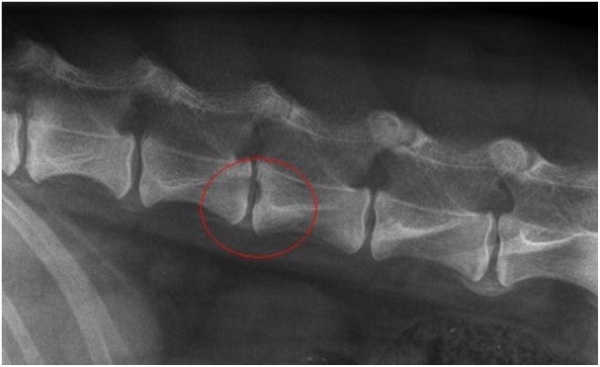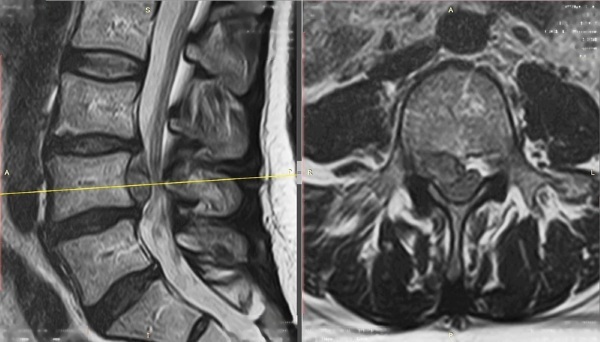A condition called hernia sequestration - This is a prolapse of the nucleus pulposus of the intervertebral disc. The site is called sequestration. Due to the nucleus, the smooth transition of the load from the vertebra to the vertebra is carried out when walking and running.
Normally, disc aging should be uniform. But under the influence of certain factors, the distribution of the load changes. Further, a hernia is formed. During sequestration, dead tissue is rejected from living tissue. That is, the hernia enters the spinal canal.
Often during sequestration, people are given a disability group. This is due to the compression of the nerves that travel to the limbs and organs. As a result, nutrition is disrupted, functionality changes. If you do not engage in sequestration therapy, the nerves atrophy.
Another danger of the disease is the reaction of the immune system. It protects the body from a foreign object that has entered the spinal canal. Further, the inflammatory process and edema develop.
Therefore, the sequestration of a herniated disc requires timely diagnosis and therapy.
Record content:
- 1 Views
- 2 Stages and degrees
- 3 Symptoms
- 4 Reasons for the appearance
- 5 Diagnostics
- 6 When to see a doctor
- 7 Prevention
-
8 Treatment methods
- 8.1 Medications
- 8.2 Traditional methods
- 8.3 Operation
- 8.4 Other methods
- 9 Possible complications
- 10 Video about spinal hernia
Views
Sequestration of a herniated disc has a classification.
There are the following types of the disease:
- anterolateral hernia - the prolapsed nucleus is outside the anterior semicircle of the vertebral body;
- posterolateral hernia - prolapse through the posterior half of the annulus fibrosus;
- median hernia - sequestration along the midline;
- paramedian hernia - loss close to the midline;
- foraminal hernia - located on the side of the posterior longitudinal ligament.
Depending on the localization of the nucleus pulposus, hernias are divided into types.
Classification:
- in the cervical spine - sequestration of the C6-C7 or C3-C4 disc, in which nerves are pinched, the contents of the vertebrae are released, blood flow is disturbed;
- in the lumbar region - Herniated disc L4-L5 occurs most often, symptoms include problems with keeping the back straight, impaired movement and sensitivity;
-
in the lumbosacral region - sequestration in the L5-S1 hernia is characterized by a violation of the functionality of the genitourinary organs, which is expressed in uncontrolled urination.

The hernia is localized in the vertebrae with increased stress. Most often, the disease is diagnosed in the lumbar region.
Stages and degrees
In addition to the types and types, the herniated disc has another classification.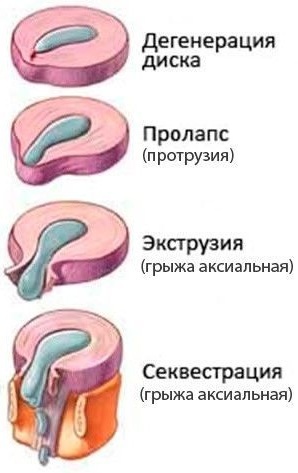
Disease stages:
- First. Another name for the stage is initial. The disc degenerates, that is, it becomes thinner. In addition, an offset of 2 - 3 mm appears.
- Second. Another name is prolapse. The disc bulges into the spinal canal, but the annulus fibrosus does not rupture. The displacement is significant - from 4 to 10 mm. The deformed parts reach the nerves, negative symptoms appear.
- Third. The stage is called extrusion. The kernel extends outside the disk. The stage is manifested by painful sensations. Extrusion is a formed hernia.
- Fourth. Sequestration appears. The nucleus pulposus protrudes into the spinal canal.
Symptoms
Sequestration is characterized by certain characteristics. With pathology, neurological symptoms increase rapidly.
General signs of the disease:
- Painful sensations of an acute and strong nature, which are localized in the neck, head and limbs. People with the disease indicate that the discomfort is similar to a lumbago. Painful sensations appear after physical activity, falling on the spine, and intensifies with a change in body position.
- Limited limb mobility. With the localization of a hernia in the neck, the symptom manifests itself on the hands. With sequestration in the lumbosacral region, the mobility of the lower extremities is limited. Additionally, a change in gait, impaired movement of the arms and legs are noted. As the disease progresses, limb paralysis may develop. If the cervical spine is affected, complete paralysis of the body is allowed.
- Change in limb temperature. The indicator becomes below normal where the nerve is compressed by sequestration. The skin of the limb may be dry or sweaty.
- Muscle atrophy of the injured limb. The fibers become thinner, their volume decreases. The symptom manifests itself if a person does not seek help from a specialist.
- Change in blood pressure.
- Numbness of the skin. Additionally, the sensitivity of the cover is disturbed, a person feels the crawling of flies.
- Intoxication of the body, which develops due to an immune response. Symptoms include a weakened condition, muscle and joint discomfort. Additionally, there is no appetite, nausea occurs.
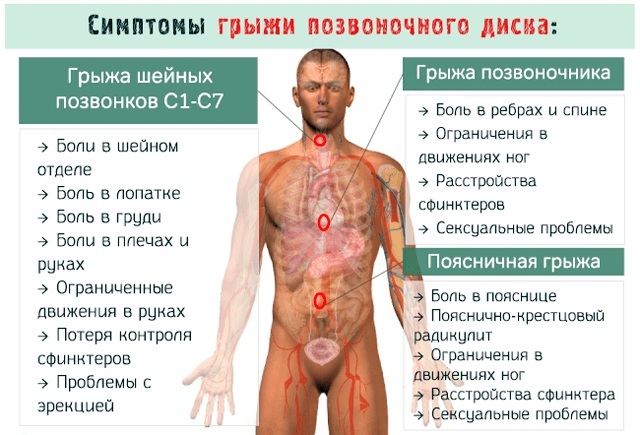
The specific signs depend on the section in which the hernia is located. Details are shown in the table.
| Localization | Numbering of the vertebrae with frequent localization of hernia | Symptoms |
| Neck section | C3-C4, C6-C7 | The presence of a hernia in the cervical spine can be suspected by the following symptoms:
With the defeat of the neck, complete paralysis is not excluded. In addition, respiratory arrest is possible. |
| Breast section | A place with a rare localization of a hernia. | Discomfort in the chest, aggravated by coughing, sneezing, or taking a deep breath. |
| Lumbar section | L4-L5, L5-S1 | If the hernia is in this section, the following symptoms appear:
The listed symptoms are cauda equina syndrome. Symptoms occur when nerves in the terminal section of the spinal cord are damaged. |
Reasons for the appearance
Sequestration of a herniated disc is a pathology that can appear for various reasons.
The following features are distinguished:
- osteochondrosis - a disease characterized by a violation of the functionality of the intervertebral discs;
- abnormal structure of the vertebrae;
- constant and strong physical activity on the spinal column, playing sports without warming up the muscles;
- an injury resulting from a fall on the spinal column or a blow to the back;
- a person suddenly lifts weights;

Movers are most susceptible to sequestration of herniated discs - improper performance of physical exercises, in which the load on the spinal column increases - squats or bends;
- overweight and obesity;
- frequent hypothermia;
- heredity;
- bad habits (smoking, drinking alcohol and drugs) - the item causes a violation of the blood supply to the fibrous ring;
- metabolic disorders - diabetes mellitus, hypo- and hyperthyroidism;
- features of work - an increased risk of sequestration of a herniated disc is in drivers, office workers.
Most often, the disease appears due to osteochondrosis. The disc becomes thinner and loses moisture, as a result of which its elasticity is impaired. Over time, the ability to withstand heavy loads that are placed on the spine decreases. As a result, even a small force can lead to displacement and injury of the disc, as well as the formation of sequestration.
Diagnostics
Sequestration needs diagnosis. The examination allows you to determine the herniated disc and prescribe therapy. The table shows the diagnostic methods that are often prescribed for the disease.
| Name | Description |
| Complete blood count (CBC) | With the help of research, you can assess the state of human health. In the result sheet, the value of important indicators (hemoglobin, erythrocytes, etc.) is indicated. It is better to donate blood on an empty stomach, after at least an 8 hour night fasting period. If a person cannot come to take a biomaterial in the morning, an analysis is allowed in the afternoon. In this case, a light breakfast is possible 6 hours before the KLA. The biomaterial is taken from a vein or finger. Most private laboratories use the first method, as the result is more accurate. The analysis will be ready in 1 - 3 days. |
| General urine analysis (OAM) | The study allows you to identify diseases of the urinary organs, gastrointestinal tract (GIT). The result sheet indicates the color, volume, smell of urine. Additionally, attention is paid to the foaminess, transparency, and density of the biomaterial. And also, as a result, indicate the value of important indicators (protein, leukocytes, and more). Stages of collecting biomaterial: 1. Prepare collection container. You can purchase a sterile container in advance from the pharmacy chain. But it is allowed to replace it with a jar (no more than 200 ml). The container must be washed, scalded with boiling water, dried. There is no need to process the pharmacy container, it is sterile. 2. Wash off with warm water and baby soap. It is better not to use antiseptic solutions (Miramistin, Chlorhexidine) for these purposes, as the result of the analysis can be distorted. 3. Collect morning urine that has accumulated in the bladder at night. It is necessary to flush a little biomaterial into the toilet, then, without stopping the process, fill the container. For analysis, 50 ml of urine is sufficient. 4. Close container tightly. 5. Deliver the container to the laboratory within 2 - 3 hours. Store the container in the refrigerator. The analysis production time is from 1 to 3 days. |
| Spine x-ray | Exposure to X-rays, in which it is possible to assess the condition, structure, functionality of the spine. The procedure is used to identify the features of the bone tissue, including thickness and density. Additionally, you can see the defeat and thinning of the column, the presence of a tumor. Among the advantages, the following factors are noted:
Among the disadvantages can be noted the low information content, compared to computed and magnetic resonance imaging. Another negative property is radiation. The procedure should not be done often, as the body is affected by radiation. There are several types of X-ray units:
To take a picture, a person must lie on a special table or stand in front of the screen (depending on the device). In order for the picture to be of high quality, the medical professional asks to hold your breath and exclude movement. |
| Computed tomography (CT) of the spine | Exposure to X-rays on the body. But CT is different from X-ray. In a conventional study, the rays pass through human tissue at a right angle, a two-dimensional image is obtained. A CT scan is characterized by a series of images from different points. After processing, three-dimensional images are obtained. The procedure is used to diagnose pathologies of the spine. Pros of CT:
Negative qualities:
Stages of CT: 1. The person is injected with a contrast agent, if necessary. The drug improves visualization. 2. The patient lies down on a special tomograph table. 3. The table gradually moves relative to the emitter and detectors. The rays pass through the body and hit the sensors, the information goes to the computer. 4. Pictures are being formed. A CT scan of the spine lasts from 5 to 30 minutes. |
| Magnetic resonance imaging (MRI) of the spine | The procedure involves the effect of a magnetic field on the body. MRI allows you to assess the structure of the vertebrae, discs and nerve endings. Positive qualities of the research:
Despite the large number of advantages, MRI has negative qualities. Namely:
The cost of an MRI scan depends on the clinic and the area of study. A complex procedure will be more expensive than examining a specific part of the spine. The average cost for a separate region is from 4000 to 6000 rubles. The price for an MRI of the entire spine starts at 10,000 rubles. The stages of the procedure depend on the type of device. The following devices exist: 1. Closed type. The patient lies down on a moving couch. If necessary, inject a contrast agent. The couch enters the elongated chamber, scanning begins. 2. Open type. In this case, the scanner is located at the top of the couch, and the view from the sides remains. This type is suitable for people weighing more than 120 kg or with an unstable psyche, small children. The patient lies down on the couch, if necessary, a contrast agent is injected, scanning begins. The examination of the spine takes 20 - 40 minutes. MRI and CT are often compared to each other. Each procedure has its own pros and cons. The required diagnostic method is selected by the doctor. |
| Electromyography (EMG) | The electrical activity of the muscles at rest and during contraction is examined. EMG detects muscle and nerve diseases. You can find an intervertebral hernia, sclerosis. The procedure is performed while lying or sitting. An electrode needle is inserted into the muscle, the conductor itself is connected to a device that records activity. First, the information is recorded at rest. Then the doctor asks to contract the muscle. During the procedure, the electrode can be inserted in different places. The procedure takes 30-60 minutes. |
| Ultrasound examination (ultrasound) | Exposure to ultrasonic waves, in which it is possible to identify diseases of the spine. Pros of ultrasound:
With ultrasound, it is not possible to examine the bone structure in detail, but analysis of soft tissues is allowed. The study reveals osteochondrosis, hernia, congenital malformations. To examine the spine, transabdominal ultrasound is used. A gel is applied to the skin, which improves visualization, and the sensor is guided over the cover. An ultrasound scan lasts from 15 to 40 minutes. |
Before undergoing diagnostics, you must follow the preparatory rules. Your doctor will recommend them.
The cost of diagnostics may vary depending on the list of procedures, a specific clinic and city. Therefore, it is better to find out the price in the organization. You can get diagnostics free of charge. To do this, you need to contact the clinic with a compulsory health insurance policy (MHI).
When to see a doctor
Sequestration of a herniated disc is in the competence of a neurologist. If symptoms of the disease appear, you should consult a doctor. The specialist conducts a survey, during which you need to describe all the signs. Then an examination is carried out, indicators are measured (blood pressure, temperature, pulse). Next, diagnostics are prescribed.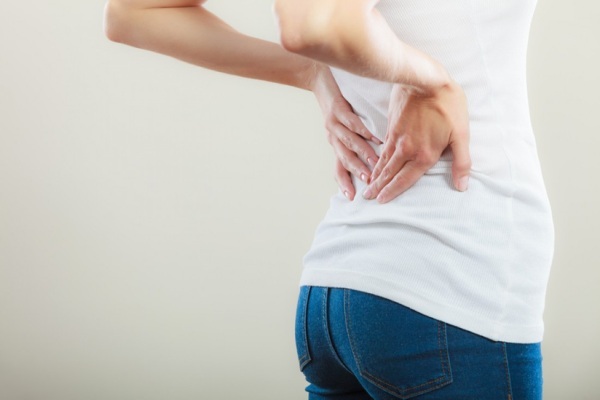
If it is not possible to visit a neurologist, it is allowed to contact a therapist. The doctor will conduct a survey and examination, prescribe a diagnosis or write out a referral to the necessary specialist.
Prevention
You can reduce the likelihood of getting the disease by using preventive rules.
They include the following measures:
- timely treat pathologies of the spine, and especially osteochondrosis;
- exclude heavy loads on the spine;
- avoid spinal injuries;
- warm up muscles before physical activity;
- do the exercises correctly;
- monitor body weight;
- avoid hypothermia;
- eliminate bad habits;
- promptly treat metabolic disorders;
- if during work there is a large load on the spine (driver, working at the computer), every hour it is necessary to take breaks of 5 - 10 minutes;
- make an appointment for a preventive examination once every 6 months;
- undergo a complete examination of the body 1 time in 12 months.
Treatment methods
The disease needs treatment. Therapy is prescribed after receiving the diagnostic results. As a treatment, drugs, folk methods and more are used.
Medications
Medicines help to eliminate the manifestation of symptoms and make a person feel better. Medicines that are prescribed for sequestration of a herniated disc are indicated in the table.
| Group name | Action | List of funds |
| Non-steroidal anti-inflammatory drugs (NSAIDs) | The drugs relieve pain and inflammation. | Nurofen, Ibuprofen, Nise |
| Analgesics | Medication fights pain. | Analgin, Baralgin, Took |
| Glucocorticosteroids (GCS) | Hormonal agents that reduce inflammation. Additionally, corticosteroids stabilize the immune defense. | Prednisolone, Metronidazole |
| Muscle relaxants | The drugs relax the muscles. | Midokalm, Sirdalud, Baklosan |
| Diuretic | Medicines remove excess fluid from the body, eliminate edema. | Hydrochlorothiazide, Diuver, Veroshpiron |
| Vitamin complexes | B vitamins help restore impulse to nerves that are trapped in sequestration. | Pentovit, Kombilipen, Milgamma |
Traditional methods
Herbal recipes are natural so they rarely cause side effects. If you use only folk remedies for sequestration, therapy will be ineffective. It is better to apply the methods as part of a comprehensive treatment.
Popular herbal recipes:
-
A flatbread made of honey and flour. To prepare the recipe, you need to take both components in such an amount that you get a dough-like mass. If there is only solid honey, it is better to melt it. The flatbread should be up to 1 cm thick. It is necessary to apply the mass to the place of hernia formation, close it with a plastic bag. Next, you need to go to bed, avoid unnecessary movements. The course of therapy is 10 days. Better to use the recipe before bed.

- Tincture for grinding. To prepare a recipe, you need to take 1 glass of alcohol or vodka and 1 - 2 tbsp. herbs. From plants you can take mint, St. John's wort, saber. And also sweet clover, wormwood are suitable. The use of one herb or several is allowed. The plant needs to be poured with alcohol, left in a cool and dark place for 1 month. Filter through cheesecloth, rub into the skin once a day. The course is 10 days.
Operation
Surgery is an effective treatment for sequestration.
The operation is performed in the following cases:
- severe pain that does not decrease with taking medications;
- sequestration size exceeds 15 mm;
- extended numbness zone;
- increased weakness in the limbs;
- paralysis;
- inflammatory process;
- lack of effect from conservative therapy.
Intervention can be carried out in different ways:
- endoscopic - with the help of microsurgical instruments, the sequestration is removed and the intervertebral disc is stabilized, the operation does not require a large incision, the conduction is monitored using a monitor;
-
open - the sequestration is removed, unstable vertebrae are strengthened with metal plates (if they can be displaced).

And also there are other methods of operation. The type of intervention is selected by the doctor. The specialist takes into account the manifestation of symptoms, the individual characteristics of the organism.
Other methods
Sequestration of a herniated disc is a disease that is treated with drugs, folk remedies, and surgery. But in addition, other methods of therapy can be used. They are shown in the table.
| Name | Description |
| Physiotherapy | The method of therapy allows you to reduce the swelling of the nerves and eliminate muscle spasm. With sequestration, the following procedures can be prescribed:
|
| Acupuncture | The impact of special needles on certain points of the body. As a result, the conduction of the impulse along the nerve fiber is improved. Acupuncture helps prevent paralysis. |
After the pain sensations have decreased, the person's well-being has improved, the doctor may prescribe massage, physiotherapy exercises.
Possible complications
The disease is characterized by complications. Most often, the consequences appear with late treatment or lack of therapy.
Possible complications:
- chronic autoimmune inflammation;
- paralysis;
- impaired blood circulation in the spinal cord;
- impaired functionality of the pelvic organs;
- cessation of breathing;
- the development of pain shock;
- disability;
- death.
A disease called hernia sequestration is characterized by prolapse of the nucleus pulposus of the intervertebral disc. Symptoms include severe pain, limited mobility. If you suspect a disease, you must contact a specialist who will send a person for examination. After receiving the diagnostic results, treatment is prescribed.
Therapy may include the use of drugs, folk remedies, and other methods. They also carry out surgery. Timely therapy is necessary in order to avoid serious consequences (paralysis, respiratory arrest, death).
Video about spinal hernia
Treatment of a sequestered herniated disc:

